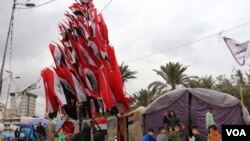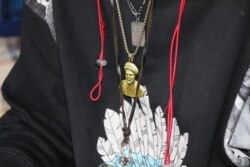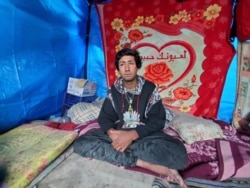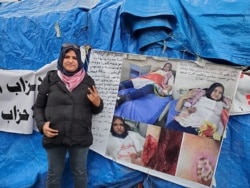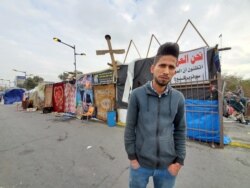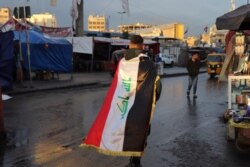“Militias kidnapped my son,” shouts Umm Mohammad, a 43-year-old mother of two, under a tent awning in central Baghdad. “Why isn’t anyone doing anything?”
Businesses around here have been closed for months as full-time protest camps occupy Tahrir Square and the surrounding area. Roads are shut down, and a tower of Iraqi flags resembling a Christmas tree blows in the wind. The only vehicles are motorcycles and three-wheeled Tuk-Tuk cars.
Most of the protesters’ demands have not wavered since the demonstrations began in October. They say they want jobs, health care, security, an end to widespread abject poverty and corruption, and new leadership. But as Iraq continues to be the battleground for the United States’ and Iran’s ongoing crisis, protesters are expected to expand their demands on Friday.
Muqtada al-Sadr, a prominent Shi’ite cleric and leader, has called on his supporters to join the rallies then to demand U.S. forces leave Iraq.
Until now, the protests have been largely non-sectarian but many Iraqis feel this issue could divide protesters.
Sunni and Kurdish leaders boycotted a parliamentary vote to expel foreign militaries, with Nechirvan Barzani, the president of Iraq’s Kurdistan Region, later saying, “This is not good for Iraq, either now or for the future.”
But in a tent lined with blankets at the Baghdad protest camp, 22-year-old Moussa rests on a thin mattress, in bare feet and wearing necklaces with charms of Quranic verse, the Eiffel Tower and Sadr. For months he has been protesting daily against corruption and poverty, but on Friday, he is also prepared to lift his voice in support of Sadr.
“He speaks for us,” Moussa says. “He cares for people and doesn’t steal like the government.”
Local clashes
Not far from the square, a bridge is barricaded by protesters on one side and security forces on the other. Protesters say hundreds have been killed and thousands injured in clashes over the past few months.
Posters bearing the faces of the dead hang on tents and cement walls.
A crowd gathers around Umm Mohammed, the mother. They show videos on their phones of injured protesters. One woman, 29-year-old Intesar, says she was stabbed in a protest but she will not go home to rest. “I can never stop demanding my rights,” she declares.
More than a week ago, protesters imposed a deadline on the government to appoint a new head-of-state. And demonstrations on Monday intensified when the deadline passed with no apparent action. Prime Minister Adel Abdul-Mahdi continues to fill the post, despite tendering his resignation in November.
Three people were killed and dozens were injured in Monday’s clashes. By Tuesday evening, local TV reported shots fired in new demonstrations.
U.S.-Iran clashes
Early Tuesday morning, rockets landed in the heavily-fortified Green Zone in Baghdad, near the U.S. Embassy.
The rocket attack was one of several since a new crisis between Iran and the U.S. in early January, when the U.S. killed Iran’s most powerful general, Qassem Soleimani. Six others died in the airstrike at the Baghdad airport, including Abu Mahdi al-Muhandis, the deputy commander of Iran-backed militias in Iraq known as the Popular Mobilization Forces.
Iran retaliated with missile strikes on American bases in Iraq, and both sides have promised grave consequences for continued aggression.
At the base of the bridge, Karrar, an 18-year-old wearing plastic sandals and fraying jeans, says he will protest the U.S. in Iraq, but he is far more concerned with local grievances.
Like many young Iraqis, Karrar quit school when he was 12 to help support his family. Now he makes salads at a restaurant in the mornings before joining protesters each afternoon. In a country awash with oil riches, residents are hungry and living in squalor, he says.
“I’ll protest against corruption and U.S. involvement in Iraq,” adds Karrar. “But if security forces throw grenades, people will die.”




